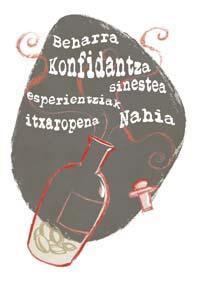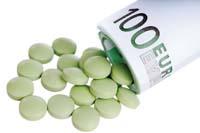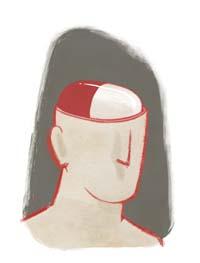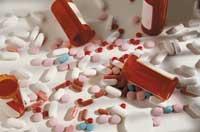Pills of hope
2010/09/01 Lakar Iraizoz, Oihane - Elhuyar Zientzia Iturria: Elhuyar aldizkaria

II. World War. The wounded grew, but morphine, less and less in the hospitals of the battered areas. In an inevitable operation of a soldier, instead of morphine, the nurse of anesthesiologist Henry Beecher desperately applied a saline solution. Beecher was surprised to see that the soldier calmed down and felt no pain. He reacted as if he had received morphine.
This was one of the first times that the placebo effect was observed in modern medicine. Since then, eleven sessions have been carried out with a placebo effect, and both the participants' statements and the researchers' measurements have shown that patients improve. Placebo, although treated without active components of spontaneous healing.
Most of the studies in which the placebos have intervened have been research to measure the efficacy of the drugs, hence, most of the available information on the placebo effect has been obtained. Through the administration of drugs or placebos to participants in the trials and analysis of their reactions, some characteristics of the placebo effect have been known. However, the doctor of the Cruces hospital, Mikel Latorre, considers that "studies are necessary to study the therapeutic effect of the placebos. But for this, funding is needed. And in addition, the pharmaceutical industry is not interested in doing so."
Despite direct or indirect research, some characteristics of the placebo effect are already known. For example, the previous experience of patients with medications, treatments, or the person who gives them treatment has a great influence on their response. And, from previous experiences and the information they receive, patients believe that the impact will be this way. This belief often causes the body to respond like this.
A psychology professor at the Norwegian University of Science and Technology, Magne Arve Flaten, observed in a study that the information provided can alter its impact. Three groups of people were given pills without any type of active substance, before they were mentioned the possible influence of treatment. One group was told that he was taking a sedative, another taking a stimulant and the third taking a pill without any effect.
Well, the results showed, in general, participants who believed they had taken a sedative with a lower level of stress and found more friends in the group who told them they had taken the awakening.
Keys: hope and conditioning
Studies on the placebo effect have shown that two are the stimuli that can cause a placebo effect: hope and conditioning. As for hope, the fact of seeing yourself at the hands of a specialist can give rise to your healing, providing the specialist. Rely on healing and the body adopts a favorable attitude.
The second stimulus, conditioning, reminds the dogs of Pavloven: when the dogs heard the fingerboard that began to flow saliva. As individuals we learn throughout life with this type of pills, which takes away the headache or relaxes us. Therefore, when we take a pill of the same look we can get the same effect, even if the pills change us and give us something ineffective.
The Australian University of La Trobe conditioned some volunteers the use of Pavloven dogs. In the experiment, it was shown that a cream without active ingredients can have an analgesic effect. To do this, they played with a machine that caused pain.
Initially, attendees were shown to cause pain by the machine. Then, to make believe that the cream eliminated the pain, they made the appearances that hurt them with the machine, once applied the cream. But they really had it off. In the end, after several attempts, patients did not feel pain when giving the cream, even though the machine was actually on.
On the other hand, two researchers at the University of California observed a strange phenomenon in patients with postoperative pain. Some were given 6-8 milligrams of morphine without knowing them or seeing them. To the others, in sight and promising to take away the pain, a pure saline solution was injected. As the patients of both groups achieved the same level of analgesia. They had to double the dose of hidden morphine to overcome the placebo effect caused by the saline solution.
This research shows that as important as believing in the efficacy of treatment is to be aware that the drug or treatment is being taken. Otherwise, no hope is generated and the influence, placebo or not, is much lower.

Sometimes yes, others do not
In many diseases it has been observed that the placebos are effective, but the effect is neither uniform nor regular. A given placebo may have a very different influence on two people, and people who have been sensitive to one need not respond equally to a placebo. Ra l of the Source, neurologist of the British Columbia University of Canada, believes that "although it is very changing, the individuals with the greatest hope of healing are those who suffer the most placebo effect".
However, placebos do not affect all diseases. In most cases, it has been observed that placebos are effective in eliminating pain. On the other hand, in patients with depression, anxiety and other psychological/psychiatric disorders it has also been observed that they have been formed with placebos.
Along with them, the other disease most commented by experts among diseases sensitive to the placebo effect by patients is Parkinson. In 2001, the British Columbia University, through the researcher Ra l de la Fuente, showed that 30% of the cases of drugs used to treat the placebos and Parkinson were similar.
Type of treatment, response
Since the placebo effect depends on the hope that occurs, the most aggressive treatments are those that have the greatest effect. Thus, it has been observed that the greatest placebo effect is due to surgery, that is, to operative simulation. Secondly, the administration of placebas substances through vaccines and, finally, the administration of placebo pills.
If, besides being in the operating room, they can see the work done during surgery or the work done in case of forensic, the recovery of the patients is faster. This was seen at St George University in London in patients with microdisectomy (intervertebral disc extraction). They had less pain and asked for less pain relievers the disc or fragment extracted after the intervention, a memory that showed they had been operated.
In the case of pills, the physical characteristics of the placebos, i.e., color, size, trade name, price, etc., influence the placebo effect. The effect is greater, for example, if patients somehow relate the color of the pills to the disease to be treated. Thus, celestine green or blue pills are used for sedatives, red and yellow for stimulants, brown for laxatives, etc.
In 2008, Dan Ariely and his collaborators at Duke University showed that expensive placebos were more efficient than cheap placebos.
The new drug also helps to improve: In the 1970s, it was observed that in 2000 a very effective drug against depression was less effective. "Simply because it didn't seem so efficient," he explains.
In short, the novelty, the prices, the appearances, the visualization of some treatment test, the previous experience, etc., affect the hope of the people who receive treatment. Hope again.

Gai honi buruzko eduki gehiago
Elhuyarrek garatutako teknologia






